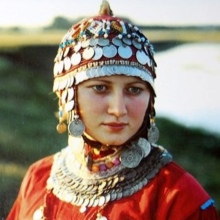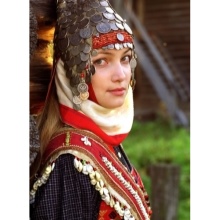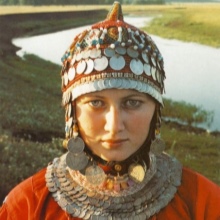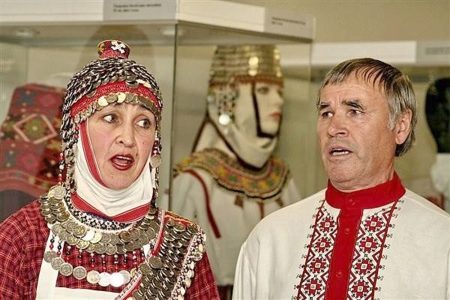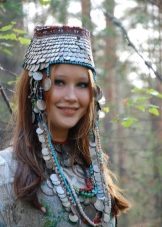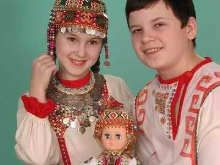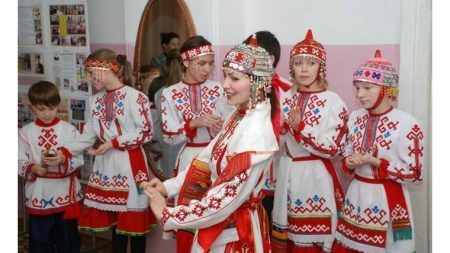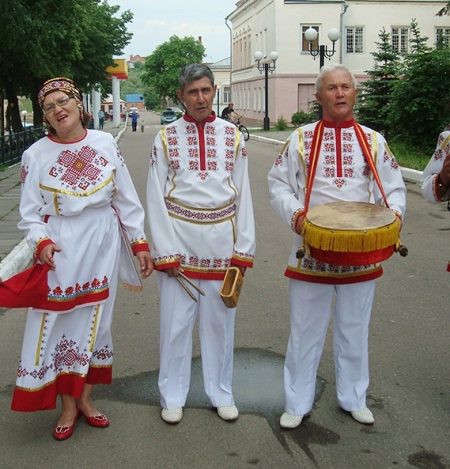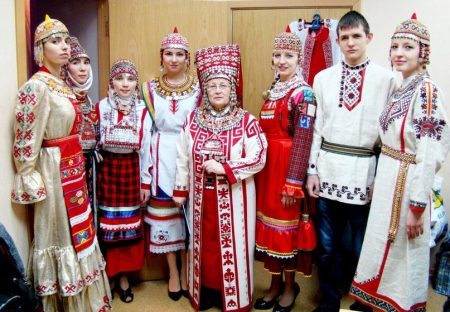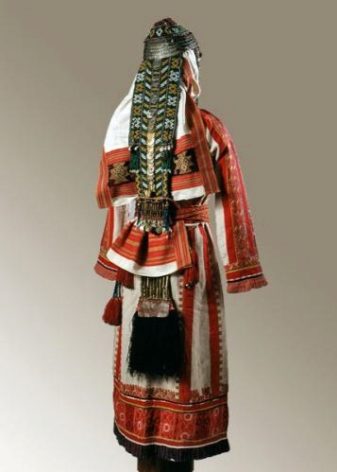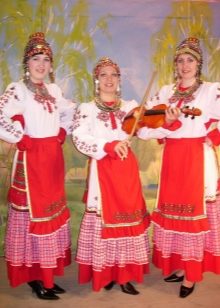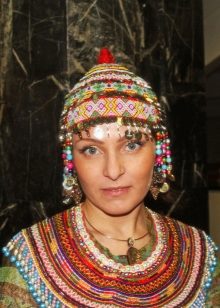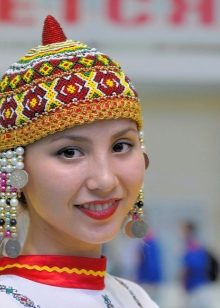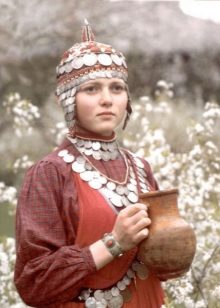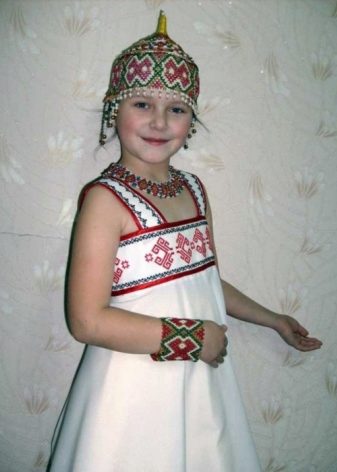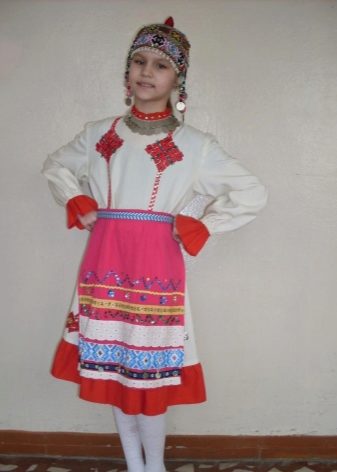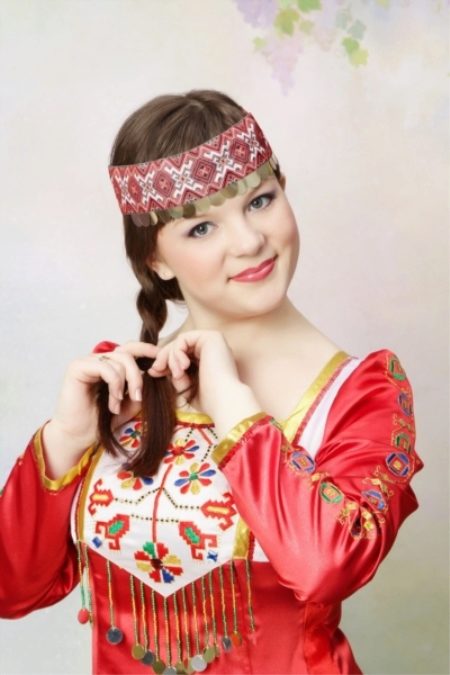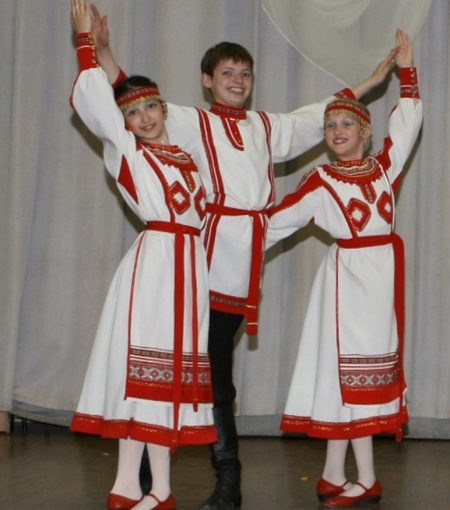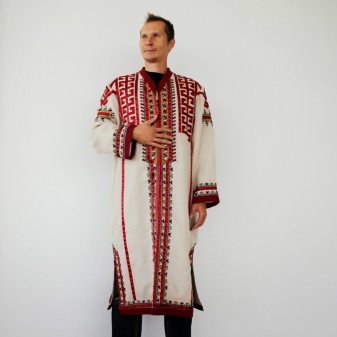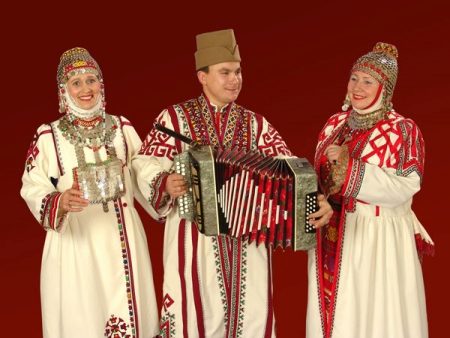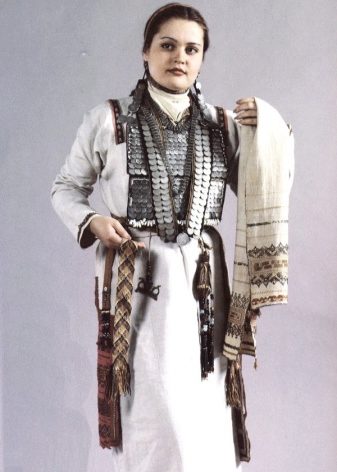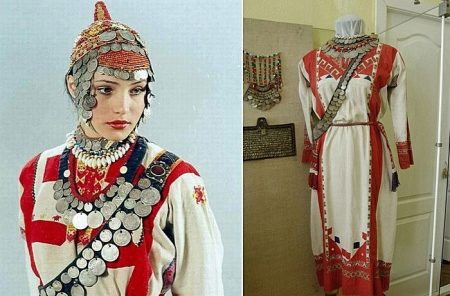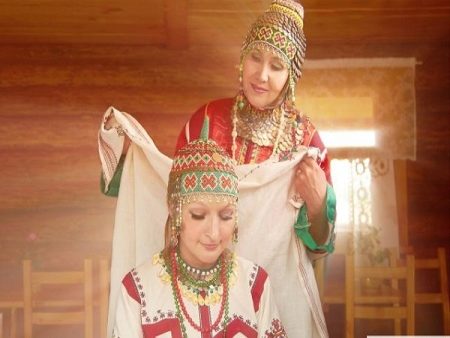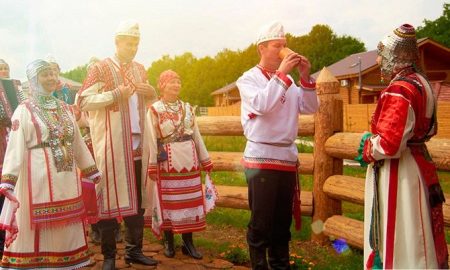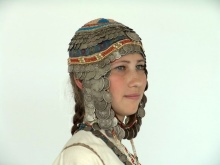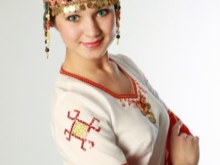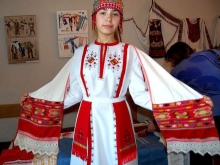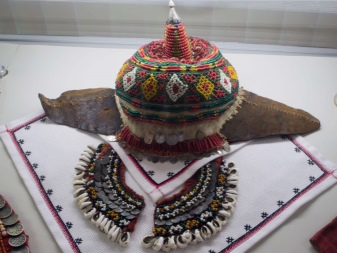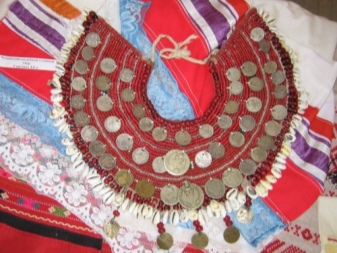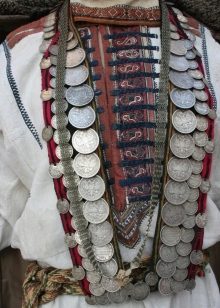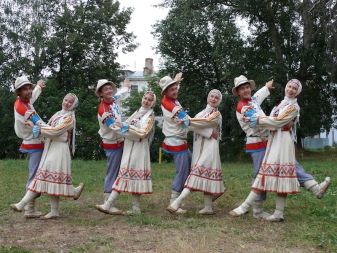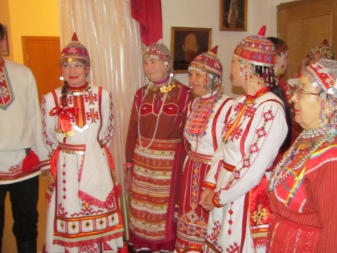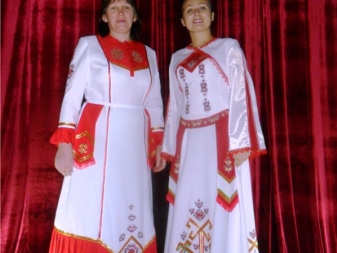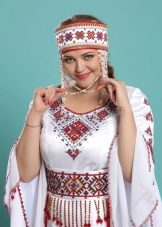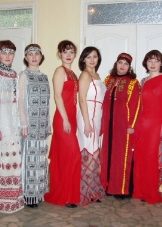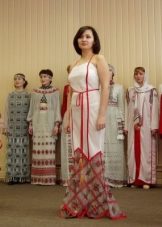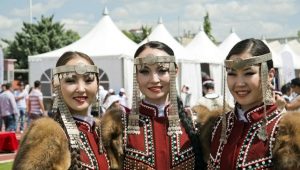Chuvash national costume

Chuvash national costume reflects the history of development, climatic conditions of existence and figurative thinking of the Chuvash ethnic group.
A bit of history
A large role in the formation of the costume was played by the place of residence of the Chuvash, who borrowed the details of the attire of their neighbors. The riding suit of the Chuvash (viryal) of the Cheboksary District was similar to the suit of the Finno-Ugric peoples of Russia - the Mari because of the brevity of the structural elements. Frills were used in the dress of the lower level Chuvash (Anatri) side by side with the Tatars, the main color of the apron was red. On towels and aprons there was decorative embroidery crocheted with threads of blue, green and yellow.
There is a link between the costume of the Chuvash of the Samara region and the Mordovian costume, expressed in the similarity of the headdress of the surpan and the breastplate and the use of colors that are not characteristic of the costume of the XIX century Chuvash. - light green, pink, and yellow.
The suit told about the status, marital status, property status, age of the owner.
Features
Colors and shades
One of the primary colors used in the costumes was white, symbolizing sacred purity. White shirt must be worn on holidays. Red in combination with white was also considered a symbol of purity, therefore it was often found in the motifs of traditional clothing. Red symbolized life, all seams on clothes were covered with a ribbon of this color.
In the XIX century. Chuvash used homespun motley in the production of clothing - a fabric of multicolored threads. In the attire of her began to vest for holidays and field work. This caused dissatisfaction with the older generation and in some cases, for example, during the flowering of rye, there was a strict ban on wearing garments of speckles. Non-observance of the prohibition to the violator was punished by pouring 41 buckets of cold water over him.
Fabrics
Until 1850, the Chuvash produced fabrics and made vegetable dyes at home. Dyeing the yarn took a lot of time, so the main color of the suit remained impractical white. And barely Anatri appeared aniline dyes, which facilitated the dyeing of the yarn, the production of pestrya began. In 1850, her outfits practically replaced white robes. In the suits of viryal pestryad not used.
Cut
White shirt Kepe was present in the female and male version of the suit. The cut was simple - hemp canvas was folded in half, inserts and wedges were sewn into the sidewalls, which extended the shirt downwards. Narrow and straight sleeves 55-60 cm long were sewn with a shirt at an angle of 90 degrees, and a square gusset was sewn into the sleeve for freedom of movement.
Women's shirts were cut about 120 cm long with a central slit on the chest, and men's shirts - 80 cm also with a slit on the chest, but on the right side.
Varieties
Female
Women's shirts embroidered on the left and right side of the slot on the chest, on the sleeves, along the seams and hem. The fundamental color of embroidery was red, and the outlines were decorated with black threads. In the embroidery came across yellow, green, and, less often - dark blue color. Embroidery on the chest was made in the form of rosettes and rhombuses.
The complex asymmetrical motif of embroidery was present on the shirts of women married. The hem was embroidered modestly and rhythmically - stripes of different sizes, geometric patterns and stripes alternated on it.
Legguards worn on weekdays and holidays.In their manufacture they used threads of silk and wool, embroidered figures resembling trees, leaves, flowers, and used stripes. Gaiters were decorated with a fringe of brown (or blue) color, which gave vividness to the costume during movement.
The costume of the girl looked modest, there was a little embroidery in it, there were no chest patterns (kezke), no sleeve patterns and shoulder pads on the shirt. It was believed that a nondescript, but neat dress more strongly emphasizes the beauty and charm of a young woman.
Headgear - Surpan, Masmak, Hushpa, Pus tutri, worn by women in marriage. The headdress of a young woman, was called tukhya.
Child
In the children's costume there were no status decorations and luxurious embroidery. The shirts were simple, of cotton or linen, the pants for small children were sewn with a neckline, the pants for older children were without a neckline. Also sewed dresses and sheepskin coats.
The girls' elegant clothes were simple; they were decorated with ready-made tape sewn onto the hemline, or with a simple pattern. Simple jewelery made of beads and braid were put on the head. Older girls could wear embroidered beaded jewelery (sarah), fastened to the back of the belt.
The collar of the boy's shirt was decorated with a monophonic ornament.
Male
The men's suit included a kepe shirt, pants (yem), boots, felt boots, a hat and a hat. It was much more modestly decorated with embroidery than female, but the decor was heavier. Signs of the sky on his shoulders, fire on his chest emphasized masculinity and significance.
Bathrobe of homespun cloth of white color was called shupar. On it were embroidered signs of fire and used silk stripes. Embroidery was located on the chest, shoulders, back, sleeves, hem, but the ornament almost did not copy the ornament of the female costume. Embroidery figures depicted horses, plants, human hands. Particular attention was paid to the backspin colorful patterns, and a sign on the border of worlds was embroidered on the sleeve.
Men's suit was complemented with cloth hats with brim, fur hats selek. Embroidery on them mostly depicted the sun and stars.
The young guys wore a scarf on their shoulders, as a symbol of the fact that the bride was chosen and that the wedding would take place soon. The girl applied all her skills to making a headscarf and gave it to a boyfriend, accepting a marriage proposal. Scarf groom put on during the wedding.
The beauty of the wedding dress
The bride's robe was embroidered with beads, shells and coins in the form of geometric patterns, and the cap was especially richly decorated.
The bride’s shirt, apron and outerwear were decorated with embroidery. The bride wore rings, bracelets, neck, breast and waist pendants, a purse and a small mirror. All vestments had a weight of about 15 kg.
An important detail of the wedding suit was a large white blanket - perchenchek, decorated with embroidery along the edges. The future wife at the wedding was under him for some time, and then the perchenchek was taken off and the bride was dressed in the dress of a married woman.
The groom wore an embroidered shirt and a caftan, a wide blue (or green) belt, boots, gloves, a fur hat with a coin on his forehead.
Accessories, shoes
Women's costume included neck, shoulder, chest and waist ornaments. Once they had the functions of amulets and talismans, but over time they simply began to denote the age and social status of the owner. For example, the harder and more varied the hacking was, the more prosperous the owner was considered.
The fair sex wore silver jewelry with beads (shulkeme). Women adorned themselves with the ama breastplate, a variation of which was the breastplate of the pushok (with the part located on the back).
Also worn decoration decorated with silver and beads over the shoulder tevet. Women complemented their wedding attire, and girls - a festive image. The girls' ornament was an uca necklace with a canvas or leather base embroidered with beads, beads and coins.
The decoration of a married woman - the necklace is dry - consisted of a thick grid of beads of various sizes, and sewn coins.
In ordinary life, viryals wore bast shoes, woven from linden bast (zapata) with black onuchami, and Anatri - with white stockings (tala calch). On holidays, they wore leather boots or shoes, and viryals wore high boots, which were assembled into an accordion. In 1900, high-laced leather boots were made for women. Valenki were used as winter shoes.
Modern models
At the beginning of the twentieth century. because of the mass production of clothes, the national costume was relegated to second place. But in the villages, the costume has retained its relevance today as a dress for celebrations and ceremonies. It is actively used in concert activities as clothing for performances by folk groups.
Nowadays, when creating clothes, fashion designers do not copy the traditional costume, but use associative images and its elements, trying to carry out the details of traditional patterns, and convey the value of handmade work while creating the costume.
